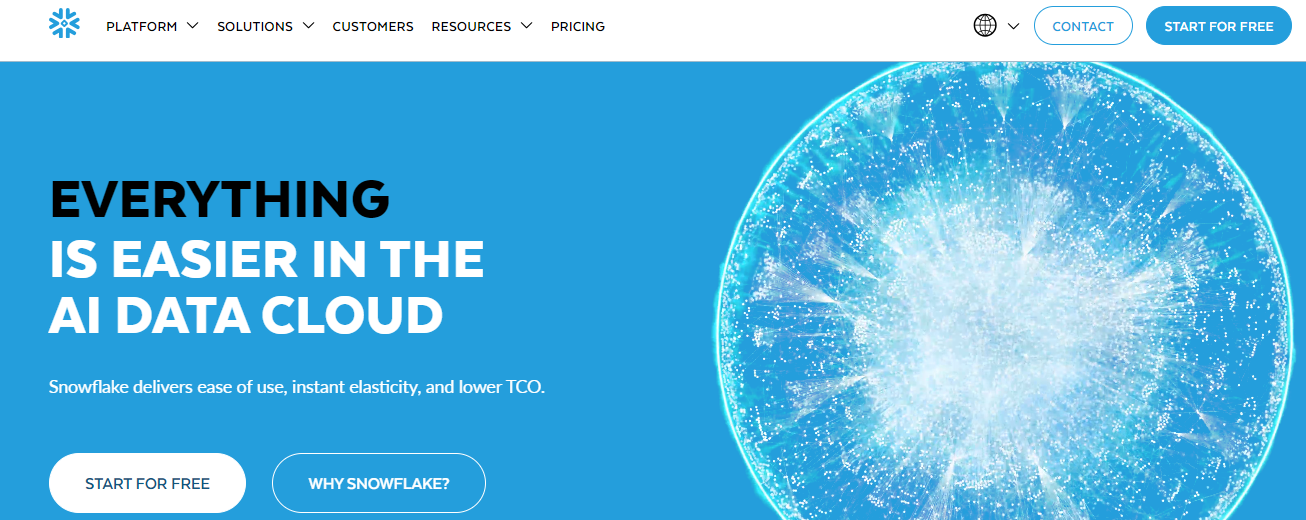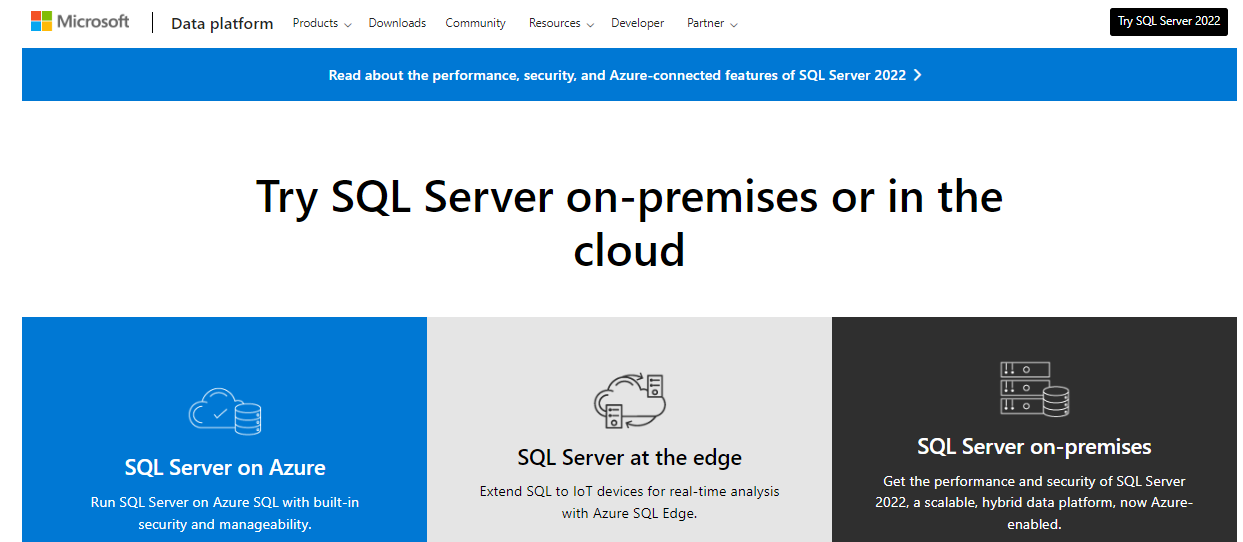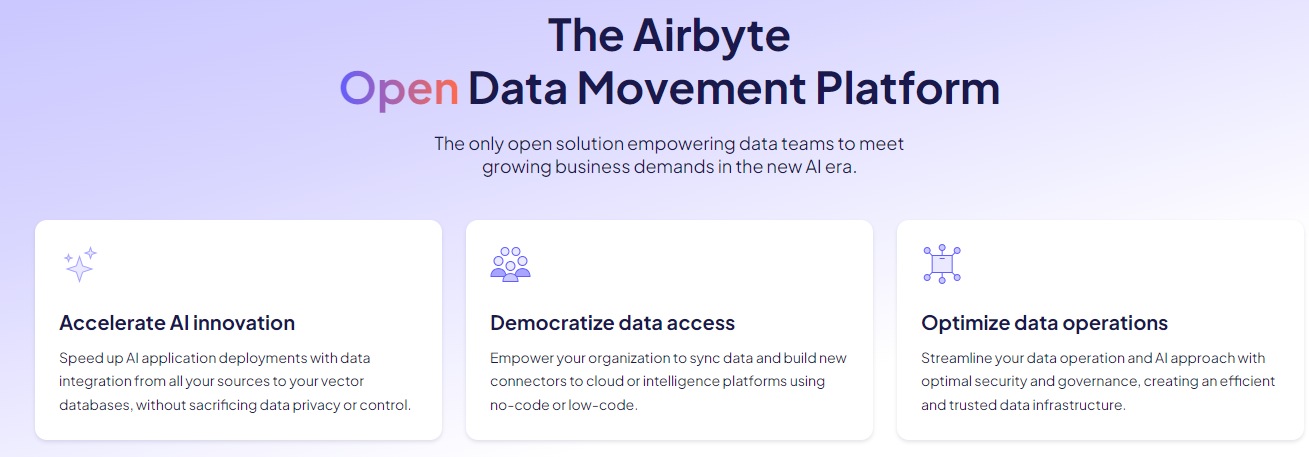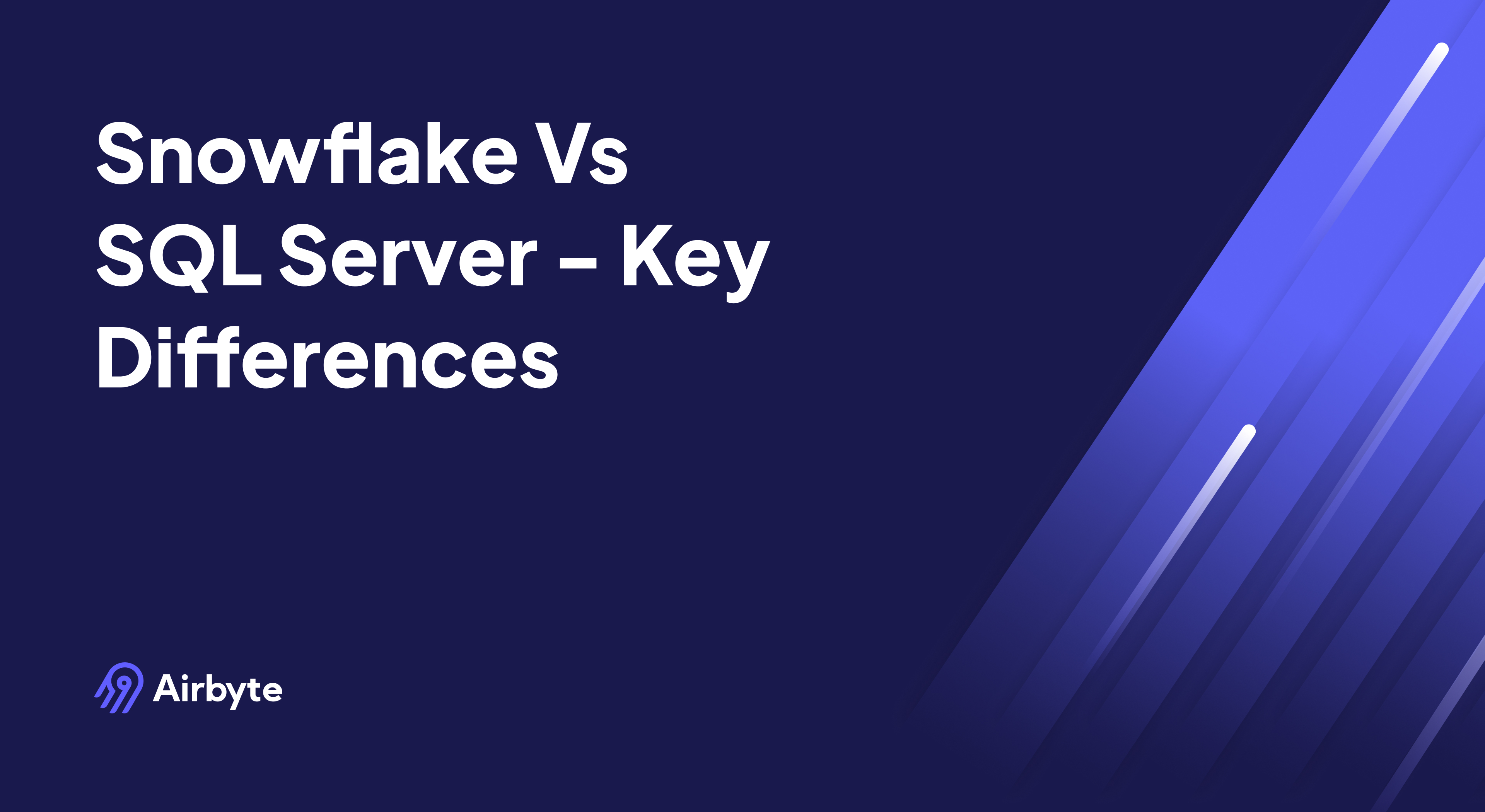Snowflake Vs SQL Server - Key Differences
Summarize this article with:
✨ AI Generated Summary
Snowflake is a cloud-native, scalable data platform optimized for analytics with separate compute and storage layers, supporting multi-cloud deployments and advanced AI integration. SQL Server is a robust, enterprise-grade relational database designed for transactional workloads, offering flexible deployment (on-premises, cloud, hybrid) and deep integration with Microsoft ecosystems.
- Snowflake features include Time Travel, Zero-Copy Cloning, cross-cloud data sharing, and Cortex AI integration.
- SQL Server offers in-memory OLTP, ledger security, PolyBase, Always Encrypted, and native vector data types in SQL Server 2025.
- Security: Snowflake uses hierarchical key encryption with automatic rotation; SQL Server provides Transparent Data Encryption, Always Encrypted with secure enclaves, and Azure Key Vault integration.
- Pricing: Snowflake uses consumption-based pricing; SQL Server offers licensing and subscription models with Azure SQL Database pay-as-you-go options.
- Integration: Snowflake supports real-time ingestion via Snowpipe Streaming; SQL Server 2025 enables Change Event Streaming and AI model management within T-SQL.
- Choice depends on workload needs—Snowflake excels in analytics and cloud flexibility, SQL Server in transactional processing and Microsoft ecosystem integration.
Data management plays a crucial role in your business operations, and selecting the appropriate data-warehousing solution can greatly influence your organization's performance. Among the various options available, Snowflake and SQL Server are two popular platforms for data management and analysis. Each of these platforms brings its own set of features and strengths tailored to meet different business needs and environments.
This article offers a comprehensive comparison of Snowflake vs. SQL Server to help you determine the solution that best meets your business requirements.
What Makes Snowflake Stand Out as a Cloud Data Platform?
Snowflake is a comprehensive Software-as-a-Service solution that offers a unified platform for data engineering, data warehousing, data lakes, and data-intensive applications. It is built on a hybrid architecture combining both shared-disk and shared-nothing database architectures, which separates compute and storage. This enables you to scale your resources as needed without affecting performance.
Snowflake combines a completely new SQL query engine with an innovative architecture natively designed for the cloud. It supports major cloud platforms like AWS, Microsoft Azure, and Google Cloud. All three layers of Snowflake's architecture (cloud services, storage, and compute) are deployed and managed entirely on a chosen cloud platform.
The platform employs a decoupled three-layer architecture comprising independent layers: the Storage Layer leverages cloud object storage for structured and semi-structured data, organizing information into micro-partitions with automatic clustering, compression, and metadata tracking. The Compute Layer uses virtual warehouses that scale independently, preventing workload contention through isolated clusters with auto-suspension and resume functionality. The Cloud Services Layer manages authentication, metadata, optimization, and transactions while coordinating global compute and storage resources.

Key Features of Snowflake
- Time Travel – Access historical data that has been modified or deleted within a defined retention period (up to 90 days for Enterprise Edition).
- Fail-safe – Provides an additional layer of data recovery by retaining data for 7 days after the Time Travel retention period has expired.
- Data-quality monitoring – Built-in Data Metric Functions (DMFs) for common metrics, plus the ability to define custom DMFs.
- Zero-Copy Cloning – Quickly create copies of tables, schemas, or entire databases without additional storage costs.
- Cross-Cloud Data Sharing – Enables secure data sharing across different cloud providers without data movement.
- Cortex AI Integration – Native AI and machine learning capabilities with built-in functions for document processing and natural language querying.
How Does SQL Server Function as an Enterprise Database Solution?
SQL Server is a robust relational database-management system developed by Microsoft. At its core is the Database Engine, responsible for managing data storage, processing, and security. This engine facilitates controlled access and transaction processing, ensuring data integrity and reliability.
The platform follows a monolithic client-server model with integrated architecture where storage and compute are tightly coupled. The Protocol Layer handles communication via Shared Memory, TCP/IP, or Named Pipes, managing authentication and firewall rules. The Relational Engine comprises the CMD Parser for query validation, the Optimizer for execution plan generation, and the Query Executor for processing. The Storage Engine manages data files, transactions, logging, and indexing through buffer pools and checkpoint processes.
Beyond its core database capabilities, SQL Server offers several integrated services that enhance its functionality:
- SQL Server Analysis Services (SSAS) enables online analytical processing (OLAP).
- SQL Server Integration Services (SSIS) facilitates data integration and ETL processes.
Recent innovations include SQL Server 2025 with built-in AI orchestration, featuring native vector data types and in-engine AI model management directly within T-SQL. The platform now supports Azure SQL Database Hyperscale with auto-scaling capabilities and SQL Server on Linux through the SQL Platform Abstraction Layer for containerized deployments.

Key Features of SQL Server
- In-memory database capabilities – Built-in In-Memory OLTP and column-store indexes for faster queries.
- Ledger – Tamper-evident, blockchain-like technology that enhances data integrity and security.
- XML data compression – Introduced in SQL Server 2022 to improve storage and performance for XML workloads.
- PolyBase – Data-virtualization feature that lets you query external data sources using T-SQL without data replication.
- Always Encrypted with Secure Enclaves – Client-side encryption with confidential computing capabilities for in-memory processing.
- Change Event Streaming – Connects transaction logs directly to Azure Event Hubs and Kafka for real-time data streaming.
Snowflake or SQL Server?
Simplify Database Integrations with Airbyte Data Connectors Talk to our team →
What Are the Core Differences Between Snowflake and SQL Server?
The main difference between Snowflake and SQL Server is that Snowflake is a cloud-native data warehouse offering scalable, separate storage and compute for analytics, while SQL Server is a relational database optimized for transactional processing and enterprise applications.
Snowflake enjoys a 21.84% market share in the data-warehousing category, highlighting its popularity among organizations looking for scalable and flexible solutions. However, both Snowflake and SQL Server are prominent players, each offering unique strengths and capabilities.
Let's explore SQL Server vs Snowflake in detail.
Architecture
- Snowflake – Three-layer architecture (cloud services, compute, storage). Data is optimized and compressed into a columnar format, stored in cloud storage, and queried via virtual warehouses (MPP clusters). The decoupled design enables independent scaling of storage and compute resources.
- SQL Server – Traditional RDBMS that combines storage and compute. Uses row-based storage optimized for OLTP workloads. Primarily on-premises but also available as Azure SQL Database with Hyperscale tier offering storage-compute separation similar to Snowflake.
Data Types
- Snowflake – Supports structured, semi-structured, numeric, geospatial, string, date-time, vector, and logical data types. Custom data types are not supported, though you can define semantic categories with
CUSTOM_CLASSIFIER. Recent additions include native FILE datatype for unstructured data processing. - SQL Server – Offers traditional types (INT, CHAR, DATETIME) plus XML, JSON, spatial, etc. Custom user-defined data types can be created with T-SQL or .NET. SQL Server 2025 introduces native vector data types for AI applications.
Syntax Differences
String concatenation
- SQL Server:```sql SELECT 'Hello' + 'World';
- **Snowflake:**```sql
SELECT 'Hello' || 'World';
Aggregate functions
- SQL Server:```sql SELECT STRING_AGG(name, ', ') FROM users;
- **Snowflake:**```sql
SELECT LISTAGG(name, ', ') FROM users;
Case sensitivity
SQL Server is case-insensitive by default, whereas Snowflake is case-sensitive. For example, Table."Field" = 'Some_value' and Table."Field" = 'SOME_VALUE' return the same result in SQL Server but may return different results in Snowflake.
Pricing
- Snowflake – Consumption-based, pay-as-you-go model for storage and compute. Charges separately for data storage, compute usage, and data transfer.
- SQL Server – Licensing options include per-core, server + CAL, and subscription-based models. Azure SQL Database offers pay-as-you-go tiers. SQL Server 2022 Express is free for small-scale applications.
Feature Comparison at a Glance
How Do Security Features Compare Between Snowflake and SQL Server?
Security represents a critical differentiator between these platforms, with each offering distinct approaches to data protection, access control, and compliance management.
Data Encryption Capabilities
Snowflake employs a four-layer hierarchical key model rooted in hardware security modules. The architecture includes File Keys encrypting individual micro-partitions, Table Master Keys wrapping file keys, Account Master Keys protecting table-level keys, and Root Keys residing in HSM-protected environments. This envelope encryption strategy ensures automatic key rotation every 30 days with zero administrative overhead. Recent advancements include client-side encryption for staged data using customer-managed master keys, enabling end-to-end encryption without Snowflake accessing plaintext.
SQL Server offers multiple encryption tiers including Transparent Data Encryption for full database protection, Always Encrypted for client-side encryption where keys never leave application environments, and Secure Enclaves using Intel SGX for trusted execution environments. Always Encrypted with secure enclaves enables pattern matching and range queries on encrypted columns without exposing keys to the database engine, while Azure Key Vault integration supports customer-managed encryption keys for hybrid deployments.
Access Control Mechanisms
Snowflake implements a unified access model combining Role-Based Access Control, Discretionary Access Control, and User-Based Access Control. The platform features hierarchical roles with inheritance, Dynamic Data Masking using JavaScript UDFs, and Row-Access Policies for contextual filtering. Recent enhancements include expanded MFA methods with programmatic access tokens and Trust Center monitoring for real-time detection of excessive privileges.
SQL Server employs a layered approach with Windows and Azure AD authentication, server roles cascading to database roles and object permissions, plus Dynamic Data Masking and Row-Level Security. Recent improvements include Azure AD authentication for passwordless access and integration with Microsoft Purview for automated sensitivity labeling across hybrid environments.
Compliance Standards Implementation
Both platforms maintain comprehensive compliance frameworks. Snowflake offers 35+ certifications including SOC 2 Type II audited every 6 months, HIPAA with BAA support, FedRAMP authorization, and GDPR compliance with automated data subject request processing. The Trust Center continuously monitors MFA enforcement, privileged roles, and security policy deviations.
SQL Server leverages Microsoft's compliance ecosystem through Azure Policy enforcement, Microsoft Purview integration, and Compliance Manager for audit preparation. Key certifications include FedRAMP Moderate for Azure SQL, DISA STIG benchmarks, and PCI DSS 4.0 compliance with automated evidence generation for SOC 2 audits.
What Are the Latest Integration Capabilities Offered by These Platforms?
Modern data integration capabilities have evolved significantly, with both platforms introducing innovative approaches to multi-modal data processing and real-time connectivity.
Snowflake's Advanced Integration Framework
- Snowflake Openflow represents a paradigm shift in data movement, enabling unified ingestion of structured, semi-structured, batch, and streaming data through pre-built connectors. This managed service eliminates fragmented data stacks by supporting Bring Your Own Cloud deployment, allowing integration with virtually any data source without manual pipeline construction. The platform employs Apache NiFi architecture while maintaining Snowflake's security perimeter.
- Real-time streaming capabilities have advanced through Snowpipe Streaming API integration, enabling sub-second latency for event data ingestion directly into Snowflake tables. This reduces compute costs compared to traditional file-based ingestion while handling change data capture through metadata-enabled streams. The platform also introduced native FILE datatype and Cortex AISQL functions that parse images, audio, and documents directly in external storage, with Arctic-Extract model extending document processing to 29 languages.
SQL Server's Modern Integration Ecosystem
- SQL Server 2025 integrates vector data types and in-engine AI model management directly within T-SQL, enabling developers to invoke models from Azure OpenAI, Anthropic, or Ollama through REST APIs. The DiskANN vector index technology enables billion-scale semantic search with improved similarity matching compared to external vector databases.
- Microsoft Fabric integration enables zero-ETL connectivity between SQL Server 2025 and Power BI/Synapse. Fabric Database Mirroring facilitates near real-time data replication to OneLake with 15-second latency windows, while Azure Arc extends unified management to on-premises instances. The new Change Event Streaming feature connects SQL Server transaction logs directly to Azure Event Hubs and Kafka, providing lower I/O overhead than traditional CDC by converting database transactions into consumable event streams.
Integration Performance Comparison
Which Factors Should Guide Your Choice Between Snowflake and SQL Server?
Deployment Model
Snowflake is cloud-only, while SQL Server can be deployed on-premises, hybrid, or in the cloud. SQL Server's deployment flexibility includes traditional on-premises installations, Azure SQL Database as a Platform-as-a-Service offering, and hybrid configurations using Azure Arc for unified management across environments.
Scalability
Snowflake offers automatic, near-instant scaling with no downtime through its decoupled architecture. Virtual warehouses can scale independently within seconds, and the platform handles over 2 petabytes of data daily across customer deployments. SQL Server scales well but usually requires manual intervention, especially on-premises, though Azure SQL Hyperscale now provides auto-scaling capabilities similar to cloud-native platforms.
Data Sharing & Collaboration
Snowflake allows secure, real-time data sharing without data movement through its Data Cloud architecture, enabling cross-organization collaboration and data monetization. SQL Server supports sharing but may be more complex, particularly in on-premises environments, though recent Fabric integration improves collaboration capabilities within Microsoft ecosystems.
Integration & Ecosystem
Snowflake integrates broadly across modern cloud tooling and supports multi-cloud strategies without vendor lock-in. The platform's 600+ connectors and open standards approach enables flexibility in technology choices. SQL Server's ecosystem is tightly integrated with Microsoft products such as Azure, Power BI, and Office 365, providing seamless experiences for organizations heavily invested in Microsoft technologies.
Cost Considerations
Snowflake's consumption-based pricing aligns costs with actual usage, making it cost-effective for variable workloads and eliminating upfront infrastructure investments. SQL Server offers predictable licensing costs but may require significant infrastructure investments for on-premises deployments, though Azure SQL Database provides similar consumption-based pricing models.
How Can Airbyte Simplify Your Data-Integration Workflows?
To truly harness the power of either platform, you need to integrate data from multiple sources into your target system. This is where Airbyte can help streamline your data integration processes and eliminate the complexity of managing multiple data pipelines.

Key features of Airbyte
- CDK – Build a custom connector in ~30 minutes with the Connector Development Kit when a pre-built connector isn't available.
- Simplified AI workflows – The Snowflake Cortex destination lets you store vector data directly in Snowflake.
- Change Data Capture (CDC) – Keep targets in sync by replicating only incremental changes.
- PyAirbyte – PyAirbyte enables Python-native pipelines and integrates with Pandas, LangChain, LlamaIndex, and more.
Airbyte's open-source foundation eliminates vendor lock-in while providing enterprise-grade security and governance features. With over 600+ pre-built connectors, the platform significantly reduces the time and complexity involved in connecting various data sources to either Snowflake or SQL Server. The modular architecture handles diverse data structures through Change Data Capture and custom connectors, while dbt integration enables in-flight transformations for optimized data processing.
Organizations using Airbyte report substantial improvements in deployment speed, moving from months to weeks for new data integration projects. The platform's automated schema management and anomaly detection capabilities ensure data quality while reducing operational overhead for data engineering teams.
What's the Best Choice for Your Organization?
This article provided a comprehensive SQL Server vs Snowflake comparison, highlighting architecture, features, security capabilities, and integration options.
- If your focus is analytics, large datasets, and multi-cloud flexibility, Snowflake is likely the better fit with its cloud-native architecture and consumption-based pricing.
- If you need robust transactional processing, tight control over database operations, and deep Microsoft ecosystem integration, SQL Server excels with its hybrid deployment options and enterprise-grade security.
The choice ultimately depends on your specific workload requirements, existing technology investments, and long-term data strategy. Both platforms continue to evolve rapidly, with Snowflake advancing its AI and cross-cloud capabilities while SQL Server enhances its cloud-native features and AI integration.
Frequently Asked Questions (FAQ)
What is the main difference between Snowflake and SQL Server?
Snowflake is a cloud-native data warehouse designed for analytics, with separate compute and storage that scale independently. SQL Server is a relational database optimized for transactional processing but also supports analytics, often deployed on-premises or in hybrid Microsoft environments.
Which platform is better for analytics?
Snowflake is purpose-built for large-scale analytics and handles structured, semi-structured, and unstructured data with automatic scaling. SQL Server can support analytics but is primarily optimized for OLTP (transaction-heavy) workloads, unless deployed with Azure SQL Hyperscale or Analysis Services.
Can Snowflake or SQL Server handle AI workloads?
Yes. Snowflake integrates Cortex AI for native machine learning and vector data types. SQL Server 2025 introduces vector support, in-engine AI model management, and integration with Azure AI services, making it strong for organizations already invested in Microsoft’s AI ecosystem.

.webp)
